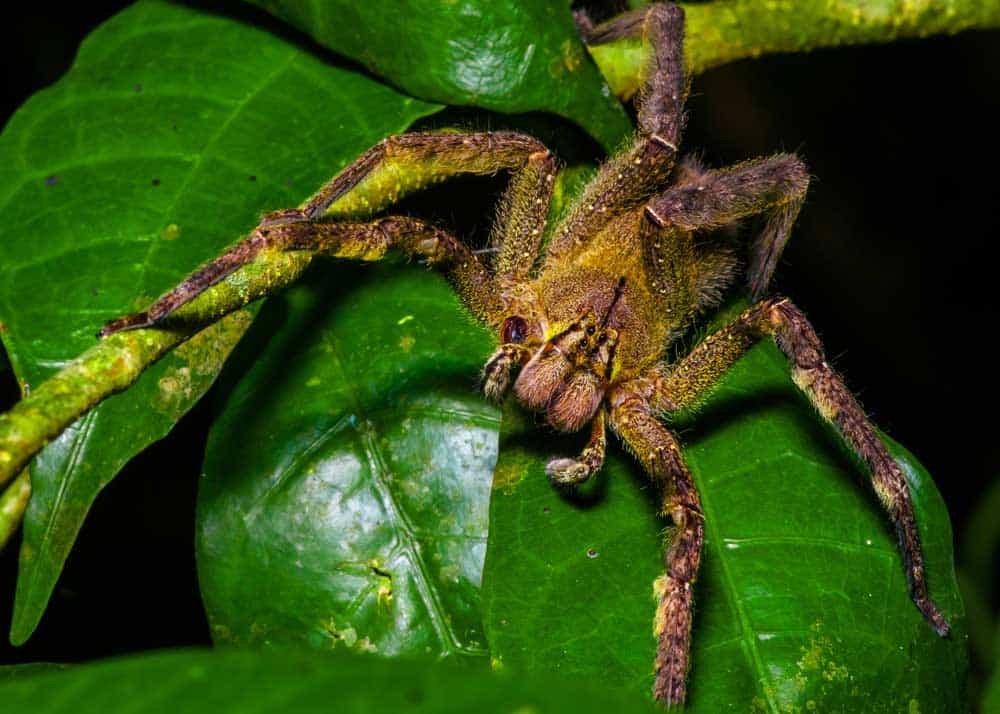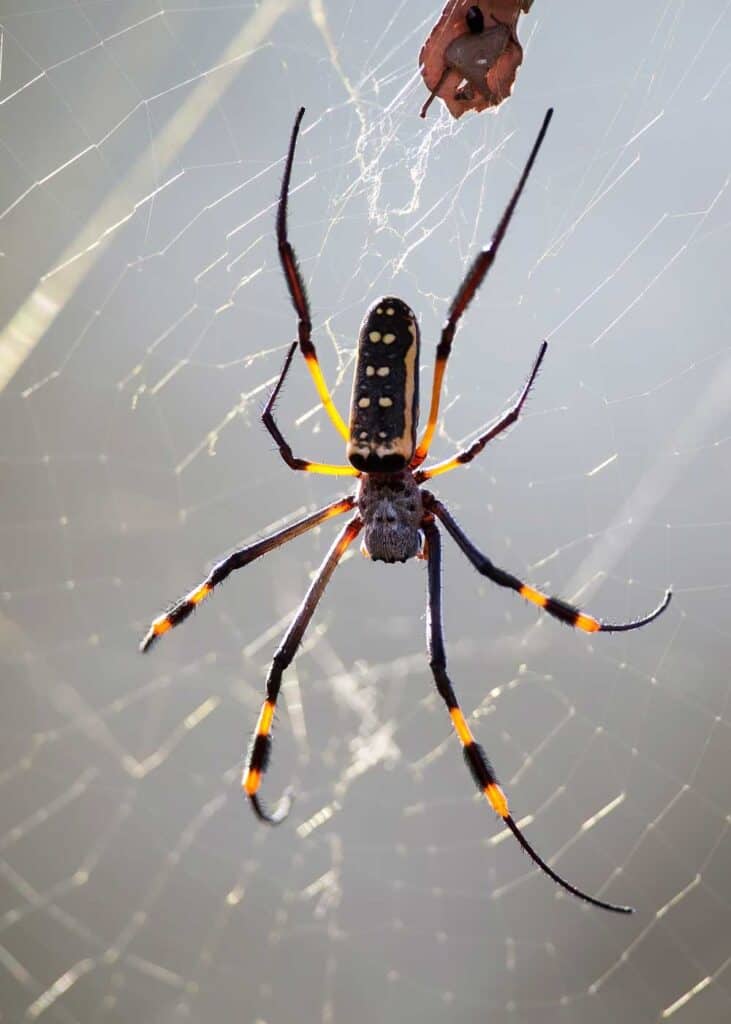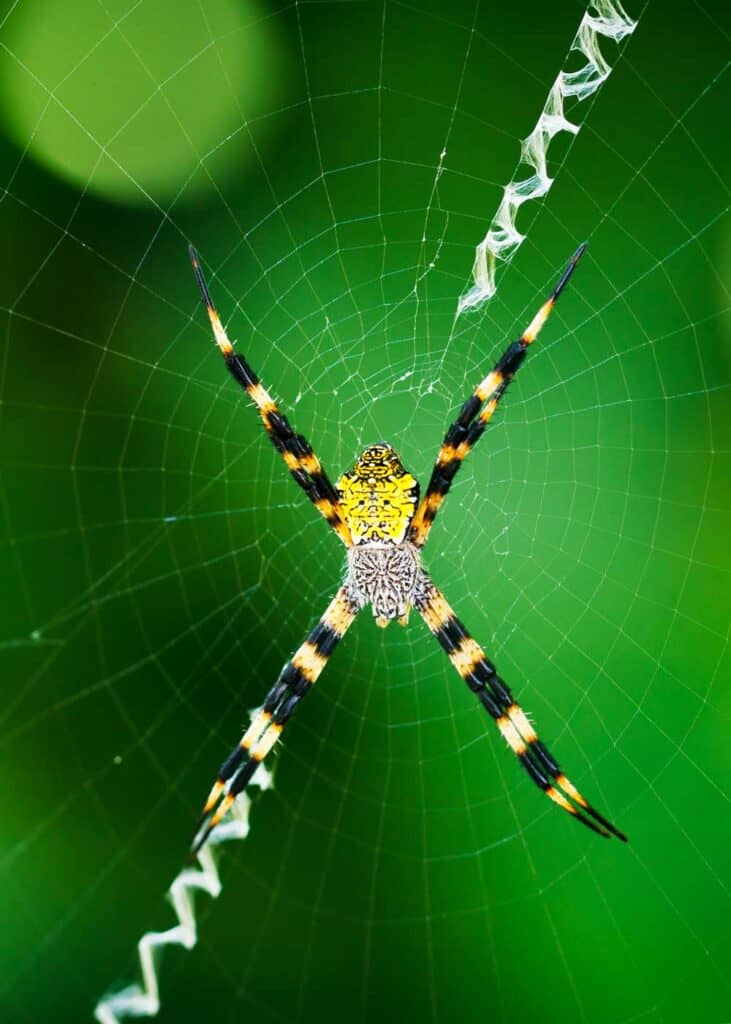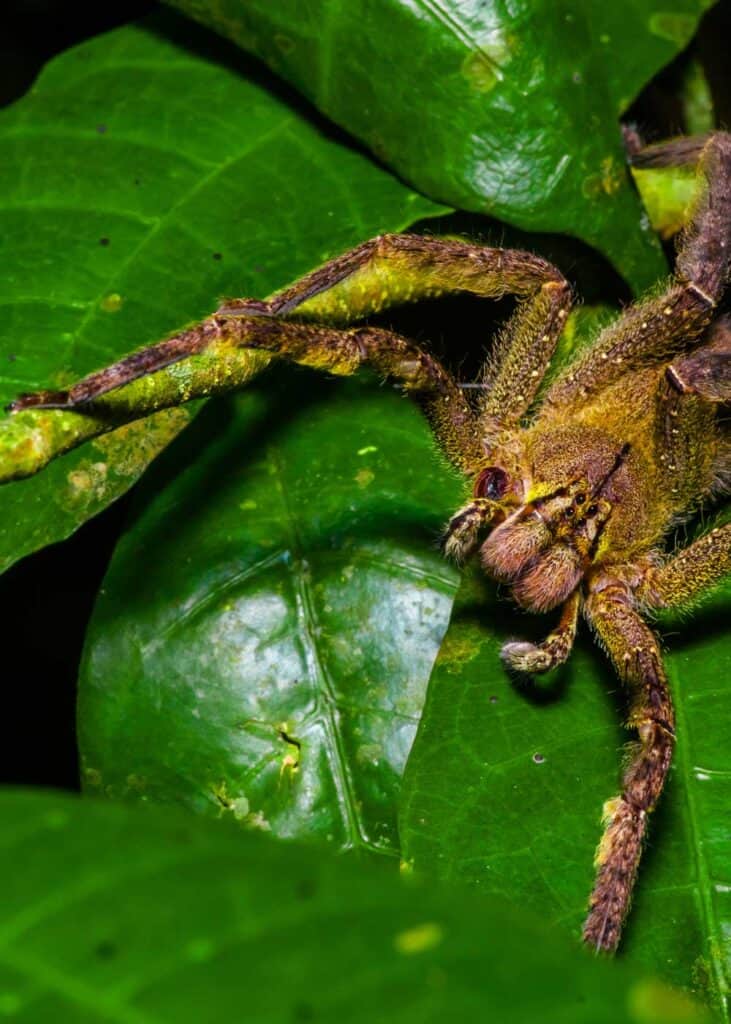Banana Spider Guide Known for their striking yellow color, banana spiders are found throughout the jungles of Central and South America as well as some regions of Asia, Australia, and the US. While most of them are harmless, there are at least one sub-species that you should keep an eye on, and not just for their selfie potential!
Let’s talk about banana spiders and what to do if you encounter them in the wild.

Table of Contents
7 Banana Spider Facts
How many types of banana spiders are there?
The term “banana spider” actually refers to multiple groups of spiders. There are two families and dozens of sub-species that use the name.
Why are they called banana spiders?
There are a couple of possible origins of the name “banana spider”.
The obvious answer is that it refers to their yellow, brown, and black coloring, but it might also come from the golden silk that some of them use for webbing.
Additionally, some species like to shelter under banana leaves or within shipments of bananas, so that could be a factor as well.
It could even be all of these things combined! Since banana spiders exist all across the world, it’s possible that they were named for different reasons by different cultures.
Are banana spiders dangerous to humans?
- Harmless: Most banana spiders aren’t a threat to humans. In fact, some are even used for healing! The Trichonephila clavipes, or golden silk orb-weaver spider, produce beautiful spider silk with many medicinal properties.
- Dangerous: Another, deadlier version of the banana spider is the Ctenidae, or the Brazilian wandering spider. These are large, hairy beasts that can take down everything from bugs to lizards, and they’ve been known to kill humans as well. Their Greek name translates to “murderess,” which should tell you everything that you need to know about their venom.
What do banana spiders look like?
The appearance of the banana spider depends on the species.
- The Trichonephila clavipes, for example, is a slender spider with either a black or yellow body. The non-dominant color appears as spots or stripes along the legs and abdomen
- Meanwhile, the Cupiennius salei is a furry brown spider
- And the Cupiennius chiapanensis is a furry brown and yellow spider with a bright red mouth
Many other species exist with variations in their appearance as well.
Where do banana spiders live?
Banana spiders live all around the globe. Their highest density is in Central and South America, but they’re also found in Asia, Australia and the Pacific Islands.
In some locations, they’re remote animals living deep in the wild; in others, they’re urban dwellers hanging out around modern homes and gardens.
Do banana spiders eat each other?
Female banana spiders often eat the males. It happens before or during reproduction. Sometimes, the luckier males won’t be eaten; they’ll just be mutilated and left to die.
Why does it occur? Well, banana spiders have a huge degree of sexual dimorphism. This means that there’s a size difference between males and females. In most species, it’s the males that are bigger than the females; with banana spiders, however, the ladies can be up to ten times bigger.
Are banana spiders venomous?
All banana spiders are venomous. However, their venom is very mild, and they’re a non-aggressive species that mostly likes to be left alone. Bites are rare, and when they occur, they usually only result in stinging and redness.
The one exception is the Brazilian wandering spider. This species has highly potent venom, and people who are bitten can suffer everything from sweating and cramping to hallucinations and paralysis. The bite can even be fatal to children.
Five Types of Banana Spiders
Now that you have a little background on the banana spider, let’s talk about specific species.
1. Cupiennius Banana Spider
- Scientific name: Cupiennius
- Common names: Banana spider, red-faced banana spider
- Location: Central and South America, The Caribbean Islands
- Size: 9 – 40 millimeters (0.35 – 1.6 inches)
- Bite: Mild with few symptoms
- Distinguishing features: Thick brown bodies, furry legs, ambush hunting, neurotoxic venom
These are the most common type of banana spiders, and they’re probably what people think about when they hear the term. They get their name from the fact that they often live in and around banana plants. They use the broad flat leaves for shade and shelter, and they often feed on prey that’s attracted by the ripening smell of the fruit.
What types of prey do they eat? They aren’t picky. They’re hefty creatures with big and bulky bodies, so in addition to the usual flies, moths, crickets, and cockroaches, they can also take down things much larger than them. They’re one of the rare species of spider that’s capable of killing things like frogs and lizards.
Another fun fact about these banana spiders is that they’re active hunters. They’re known as “wandering spiders,” which means that they find their prey by searching for it rather than building webs and waiting for the prey to come to them. They subdue their kills through a highly complex neurotoxic venom.
Don’t fret, however. While banana spiders are deadly to their foes, this type is relatively harmless to humans. Their bite is described as “like a bee sting.”
2. The Golden Silk Orb-Weaver Spider
- Scientific name: Trichonephila clavipes (formerly Nephila clavipes)
- Common names: Golden silk orb-weaver spider, calico spider, writing spider, giant wood spider
- Location: Asia, Australia, Africa, North and South America
- Size: Females: 4.8 – 5.1 centimeters (1.8 – 2 inches), Males: 2.45 – 2.5 centimeters (1 inch)
- Bite: Mild with few symptoms
- Distinguishing features: Golden webs, extreme sexual dimorphism, occasional cannibalism
Known for their intricate webs of fine, yellow-gold silk, these spiders are both beautiful and helpful.
Not only are their webs some of nature’s best works of art, but they produce seven different types of silk, including ones that are being studied for medicinal use.
One type has even been tested in human surgeries!

Their silk is also amazing to see in the wild. Their gigantic, expertly-woven webs can reach between 6.5 – 10 feet (2 – 3 meters), so they’re ideal for ensnaring bugs, birds, and even snakes. An orb-weaver spider once made headlines for catching a brown tree snake in its web and having a feast.
Despite their size, however, the webs of the orb-weavers often go unnoticed by prey. This is because their silk is a light golden color that can seem invisible under the sun.
Some of the spiders can even adjust the hue of their webs to match the light conditions of a sunny or cloudy day.
Another fun fact about orb-weavers is that the females rule the roost. They’re three times the size of the males, and they often engage in cannibalism and mutilation during the mating process.
The good news is that these spiders aren’t nearly as dangerous to humans as they are to each other. They’re weavers, not hunters, so they’re content to live by their webs and mind their own business. They only bite when provoked, and even then, their venom is harmless enough to only cause a brief sting.
Note: Orb-weaver spiders used to be known as Nephila clavipes or Nephila spiders, so you might see them classified as such in older books or websites. “Nephila” means “fond of weaving” or “lover of weaving” in ancient Greek. This is also where they get nicknames like “writing spider.”
3. Tiger Spider
- Scientific name: Trichonephila plumipes
- Common names: Banana spider, tiger spider
- Location: Australia, Indonesia, New Guinea, The Pacific Islands
- Size: Females: 34 millimeters (1.3 inches), Males: 5 millimeters (0.19 inches)
- Bite: Mild
- Distinguishing features: Striped yellow bands, extreme sexual dimorphism
This banana spider is an urban-dwelling creature often seen around homes and gardens in places like Sydney, Australia. It’s in the same family as the Nephila spiders, so it has many of the same characteristics, including a mild bite and a love of weaving elaborate, golden-spun webs.
A few things distinguish this species from its cousins. The first is the yellow- and orange-striped bands on its long black legs; for this reason, it’s sometimes called the “tiger spider.” Fun fact, however: There’s a spider species called the Linothele that looks even more tigerish, so don’t get them confused!
Another crazy fact about this banana spider is that there’s a huge difference between males and females. Females can be 10 times the size of males! Like others in their family, they often eat or mutilate the guys during reproduction.
The last thing to know about these spiders is that they’re good at running and climbing as well as weaving. Thank goodness that they shy away from humans! Imagine these monstrous, multi-powered ladies coming for you!

4. Argiope Appensa Banana Spider
- Scientific name: Argiope appensa
- Common names: Hawaiian garden spider
- Location: Pacific Ocean coastlines (Hawaii, Taiwan, Australia, New Guinea, Indonesia)
- Size: Females: 5.1 – 6.4 centimeters (2 – 2.5 inches), Males: 1.9 centimeters (0.75 inches)
- Bite: Mild
- Distinguishing features: King’s crown bodies, striped bands on the legs, decorative zig-zag webs
Another common type of banana spider, these little guys have black, brown and yellow bodies stretching into double-banded orange legs. They can also be identified by abdomens that are shaped like a king’s crown.
Argiope Appensa are common in warm and humid island climates in countries around the Pacific Ocean, including Taiwan and Australia. In Hawaii, they’re known as “Hawaiian garden spiders” because they like to chill out among the plants.
They aren’t dangerous. Like others within their family, they have a mild bite with venom that’s scarcely toxic. Many gardeners actually welcome their presence since they’ll kill pests and other nuisances.
These spiders also go to great lengths to avoid the destruction of their webs. Like the orb-weavers, they create large and elaborate constructions to trap their prey in silk threads. However, these curious creatures also bedazzle their webs with something called “stabilimenta.”
Stabilimenta are basically fancy decorations for the web. In the case of banana spiders, they create bright, visible zig-zag patterns made of a thick white webbing. It’s been proposed that these decorative elements are to keep large animals from accidentally charging or flying into the web and destroying it.
5. Brazilian Wandering Spider
- Scientific name: Phoneutria
- Common names: Banana spider, Brazilian wandering spider, armed spider
- Location: Central and South America (Brazil, Columbia, Venezuela, Guatemala, Honduras, Panama, Ecuador)
- Size: 17 – 48 millimeters (0.67 to 1.89 inches)
- Bite: Painful and potentially deadly
- Distinguishing features: Furry bodies, deadly bites
These banana spiders are the ones that you’ll want to avoid.
For starters, they have a nightmarish appearance that’ll make you think twice about approaching them. They’re almost tarantula-like with their thick, furry bodies and protruding jaws.

They’re also quite aggressive. They’re another type of wandering spider, and many of their natural habitats are close to human settlements.
Add a fondness for warm, dark places, and you have a recipe for disaster when they crawl under porches or into bags, clothes, shoes, and shipping boxes.
Like their cousins, the Cupiennius, they’re also spotted in banana bushels quite a bit, which might be one of the reasons behind their name.
The bite of these spiders is quite painful, and symptoms begin soon afterward.
Symptoms can include:
- Fever
- Nausea
- Sweating
- Cramping
- Difficulty breathing
- Increased heart rate
- Increased blood pressure
- Vertigo
- Hallucinations
- Paralysis
If left untreated, symptoms can become life-threatening. There have been many reports of patients hospitalized because of Brazilian wandering spiders.
Tragically, there have even been fatal cases among children. One story involved two sleeping boys being bitten at night and dying within hours.
If you spot these spiders in the wild, don’t attempt to engage with them. It isn’t worth it. Wait for them to leave the area on their own.
Learn more about another famous spider: 26 Facts About Brown Recluse Spiders
More reading: Do only spiders have 8 legs? 11 types of 8-legged animals
Banana Spiders: A Most Intriguing Species
Love them or hate them, but banana spiders are fascinating creatures. Some spin beautiful, intricate webs that glimmer in the sunlight; others prowl across the jungle floor as nocturnal hunters. Some can kill you; others might save your life during a surgery some day.
Do you want to know another fun fact about banana spiders? There are many species that aren’t covered here! There’s an entire world of banana spiders out there, so if you’re interested, dive into their web and see.
- About the Author
- Latest Posts
Bryan Haines is a co-founder and writer at The Buginator. And is working to make it the best resource for taking back the outdoors from biting, stinging pests.
He also blogs about travel at Storyteller.Travel and photography at Storyteller Tech. Bryan is a partner at Storyteller Media, a publishing company he runs with his wife, Dena.
